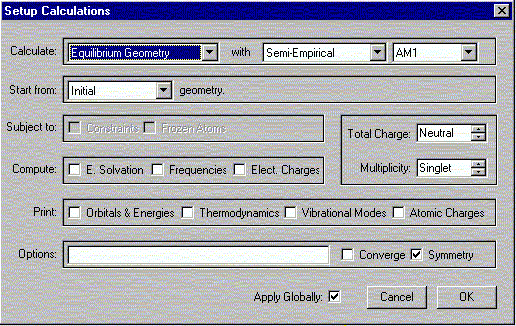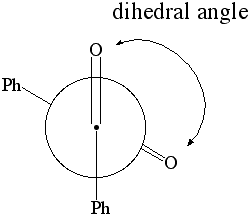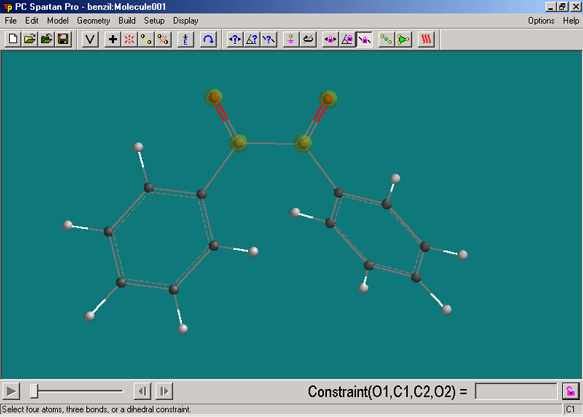updated last Mon, Aug 15, 2005
Week 4 Problem Set - 30BL (Turn in your computer assignment during week 5)
- DO PROBLEMS (I-II) DURING YOUR ASSIGNED LAB PERIOD. Include Part III into your prelab.
- ANSWERS TO THESE QUESTIONS ARE TO BE DONE IN YOUR LAB NOTEBOOK.
- This assignment is worth 10 points and should take between 45-60 minutes to complete.
- Bring a black, blue and red pen (or crayon or pencil).
- TIME SAVER HINT: PLACE YOUR PC_SPARTAN PLUS FILES ON THE DESKTOP INSTEAD OF STORING THEM ON YOUR FOLDER IN THE STUDENT DIRECTORIES. BY DOING THIS YOUR CALCULATIONS WILL BE UP TO 10 TIMES FASTER BECAUSE THEY DON'T HAVE TO USE THE NETWORK!
- ATTENTION: PC_Spartan Pro application has a problem printing!
BUT THERE IS AN ALTERNATIVE FOR PRINTING
FROM SPARTAN. Here's what do:
- Open a blank document in MS Word.
- Copy the molecule from Spartan (Ctrl C)
- Paste into Word
- And print -- voila!
PART I. (Reduction of Camphor)
This assignment is to be completed in the YH1054 (the lab will be open for most part) computing labs during the lab period (or afterwards if you don't complete it in the allotted time).
1. Optimize the above structural geometry of borneol, camphor and isoborneol. (see below instructions). Compare the heat of formation of borneol and isoborneol. Which one is thermodynamically more stable? How can you rationalize the differences?
2. Determine the dipol moment for borneol, camphor and isoborneol (see below instructions). In the GC spectrum, camphor has the shortest retention time. Borneol elutes in the end. Can you rationalize the GC results based on the calculated dipole moment of these compounds? (Note: The GC column used is an HP-5 column, which is relatively non-polar.)
Instructions:
- Use the structures that you drew during the first meeting.
- click on
 to enter View Mode
to enter View Mode
- Select Calculations from the Setup menu.

The following window should appear. Select the options shown.

Verify the Charge is Neutral and Multiplicity is Singlet. Click OK.
- Select Submit from Setup menu.

- When the calculation is completed you will be notified.
- Select Output from the Display menu.

Record the heat of formation value given
See these Helpful Hints for manipulating structures!
Note:
| 1 au = 1 hartree = 627.5 kcal/mol |
| 1 eV = 23.06 kcal/mol |
| 1 hartree = 27.21 eV |
| 1 Ångstrom = 1.889762 atomic units = 10-8 cm |
PART II. (Aldol Condensation)
|
1. Calculate the dipole moment for dihedral angles: 0 through 180 degrees in 15 degree increments. Plot the dipole moment of benzil vs. the dihedral angle.
|

Newman Projection of Benzil
|
Instructions:
- click on Constrain Dihedral angle tool,

- select the atoms shown below in the sequence O..C..C..O (and not in any other sequence!)

- Click on the lock tool,
 , in the bottom right corner so that it looks like this,
, in the bottom right corner so that it looks like this, 
- Set the dihedral angle to 0 and hit the ENTER key.

- click on the minimize tool,
 , and wait for the operation to complete.
, and wait for the operation to complete.
- click on the minimize tool,
 , a second time and wait for the operation to complete.
, a second time and wait for the operation to complete.
- Select Calculations from the Setup menu. The following window should appear. Select the options shown.

- Make sure the
 is checked.
is checked.
- Click OK to close the window.
- Select Submit from Setup menu. When the calculation is completed you will be notified.
- Under the Display menu, select Properties.

- A window should appear (the values in this example should differ from yours). If there are no values in the window then you need to double click on the molecule.

- Record the dipole moment and energy given. (In this example the dipole = 3.9 debye and the energy is -0.0095 au).
- Calculate the dipole moment for dihedral angles: 0 through 180 degrees in 15 degree increments. (Hint: Just click on the pink bond and change the value in the box.). Do not define a new constraint at this point. This will confuse the program completely!
- For the higher angles (>120 degrees), you might have to uncheck the symmetry box in the setup calculation menu. However, sometimes it works better if the approach is for the higher angles is from 180 degrees going down. If there is one angle missing in the end, do not worry too much about it.
- If the calculation leads to an error message, please check in the output what the problem is. If the calculation ran out of cycles, just re-submit the calculation.
- Using EXCEL, plot the dipole moment and energy of benzil vs. the dihedral angle (use MS Excel, XY Scatter plot). Rationalize the observed trends.
Part III: Phase Transfer Oxidation (due in prelab)
1. A student reacts 2,4,4-Trimethyl-1-pentanol with concentrated sulfuric acid at 180 oC. After drying and a second distillation, he obtains a GC spectrum for the final product on an HP-5 column.
a. Assuming that he maintain a temperature of 120 oC throughout the run, how many peaks will he observe? (Hint: You might want to think about the product(s) of the reaction?)
b. What (if any) will change if he starts at 70 oC and ramps up the temperature to 100 oC within 10 minutes?
c. Assuming that he observes three peaks with areas of 200, 300 and 500 units, respectively, what is the relative composition of the mixture?
2. A separatory funnel is used this week. Answer the following questions.
a. Why is the separatory funnel used here?
b. Why does the separatory funnel often have a 'pear shape' ?
c. Which tests should be performed prior to using the separatory funnel?
d. Why is the stopper removed on top when the solution is drained?
3. Referring to the reaction carried out in the lab, answer the following questions.
a. How could you test if the reaction is completed before you work it up? (Hint: Which reagent is limiting here?)
b. Why is a sodium phosphate solution added to the reaction mixture?
c. Why do you place the beaker with the solution under the hood when removing the solvent?
d. Outline a brief procedure how to set-up and and perform the column chromatography step.
e. Which precautions have to be taken when removing the solvent after the chromatography step?
 to enter View Mode
to enter View Mode






